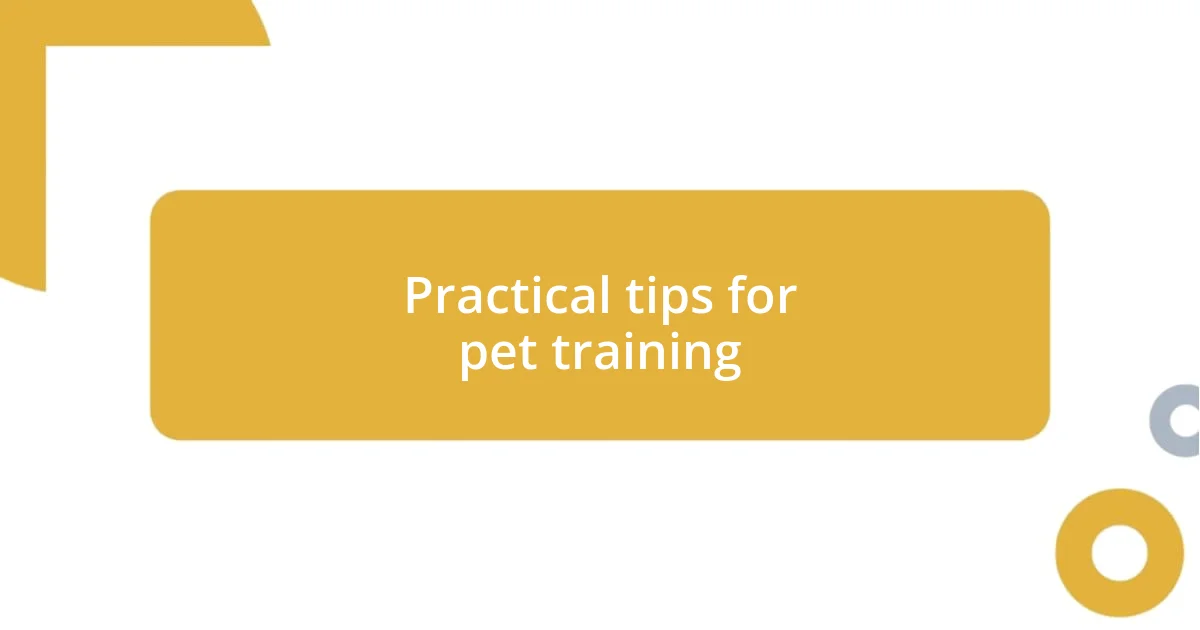Key takeaways:
- The value of community support and shared experiences among pet owners can provide comfort and insights into better pet care.
- Learning diverse care strategies from different pet owners broadens understanding and improves pet management across various species.
- Practical tips for training, such as positive reinforcement and observing calmness, can greatly enhance both training effectiveness and the owner-pet relationship.

Valuable insights from shared experiences
One of the most valuable insights I’ve gained from fellow pet owners is the significance of community support. I remember chatting with a neighbor who has a Golden Retriever. When her dog faced anxiety, she shared how local pet groups rallied around her, offering tips and emotional support. Have you ever found comfort in shared experiences? It’s amazing how a simple conversation can turn into a lifeline.
I’ve also learned that every pet has their quirks, which can often lead to unexpected bonding moments. There’s a sweet lady at the park who told me about her cat’s unique habit of bringing her socks to bed. Hearing her share the joy this little quirk brought her made me reflect on the small, silly things that enrich our lives. Isn’t it fascinating how these little stories create a tapestry of connection among us as pet owners?
Another profound lesson is the importance of patience. A fellow dog owner once opened up about her struggles with puppy training, admitting that her first dog taught her more about perseverance than any textbook ever could. I could relate; there have been times when my own pets tested my limits. How often do we realize that our pets are not just animals but teachers in disguise?

Learning about diverse pet care
Learning about diverse pet care has been a transformative journey for me. Recently, I spoke with a friend who owns a rabbit. She shared her in-depth knowledge of a high-fiber diet and the importance of social interaction for her bunny’s well-being. It really opened my eyes to how different each type of pet can be—what works for a dog or cat might not apply at all to a rabbit. Have you ever found yourself learning something completely unexpected from a fellow pet parent?
One day at the vet’s office, I overheard a conversation between two bird owners discussing the apparently calming effects of specific music on their feathered friends. This sparked a memory of how I’ve seen my own dog respond positively to soft melodies. It dawned on me that we often think of pet care within the confines of species, but there’s a broader spectrum of care strategies we can learn from each other. It’s almost like a shared language, where one insight leads you to discover another way to nurture our beloved companions.
The beauty of sharing experiences doesn’t stop there. During a local pet fair, I connected with a reptile enthusiast who taught me about the meticulous temperature and humidity needs of her lizards. I’d have never considered that level of detail had I not engaged in an eye-opening conversation. Each story we share makes us better pet owners by expanding our understanding of what different animals need from us.
| Type of Pet | Specific Care Tips Learned |
|---|---|
| Dog | Socialization and patient training strategies |
| Cat | Importance of interactive play for mental stimulation |
| Rabbit | High-fiber diet and the need for companionship |
| Bird | Calming effects of specific music |
| Reptile | Detailed habitat requirements for temperature and humidity |

Practical tips for pet training
Training a pet can be a rewarding experience full of surprising lessons. I recall a time at the park when I noticed a fellow dog owner using a simple clicker to reinforce positive behavior. Intrigued, I asked her about it, and she explained how the click sound signals to her dog that he did something right. It reminded me of the importance of consistency in training. Meanwhile, I’ve found that being in a calm state myself can make all the difference during training sessions. When I’m anxious or frustrated, my dog picks up on that energy, leading to more mischief than progress.
- Focus on positive reinforcement. Reward good behavior immediately with treats, praise, or play.
- Keep training sessions short and engaging. Aim for about 5-10 minutes to maintain focus.
- Use consistent commands. Choose clear, distinct words for commands and stick to them.
- Incorporate play into training. Make learning fun by integrating playtime to motivate your pet.
- Be patient and stay calm. Remember, it takes time for pets to learn, and they can sense your emotions.
Sharing these moments with other pet owners has really shaped my training philosophy. For instance, a friend once told me that her cat would sit quietly if she acknowledged him when he used his scratching post, instead of reacting negatively. It hit me then—shaping behavior is more effective when you catch them doing something good. Little adjustments in my approach, inspired by the observations of others, have transformed not just my training methods, but my relationship with my pets.

Handling common pet challenges
Navigating common pet challenges is often a journey of discovery fueled by shared experiences. I remember my first encounter with a cat displaying aggressive behavior when my friend suggested using a water spray bottle as a gentle deterrent. Initially, I was skeptical, thinking it might scare the cat. However, after trying this method, I noticed a significant shift in my pet’s behavior. Soon, I realized that understanding the underlying reasons for such actions—like stress or fear—was key to resolving those issues.
Another pivotal lesson I learned came from a fellow dog owner who faced separation anxiety with her pup. She shared her practice of leaving an old t-shirt with her familiar scent when she stepped out. At first, I thought it seemed simple, but I decided to give it a go. Much to my surprise, my own dog appeared more relaxed when I started using this technique. It’s amazing how a small change can make a big difference in easing anxieties, don’t you think?
Additionally, I once joined a workshop on raw feeding that another pet owner recommended. The discussions revolved around the importance of transition to avoid digestive distress. I had always stuck to kibble, thinking it was sufficient. However, the shared stories of unexpected health improvements in pets after switching to a raw diet encouraged me to explore this further. It was a reminder that when handling challenges, leaning on the knowledge of others can illuminate paths I had never considered before.














